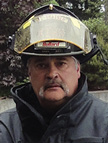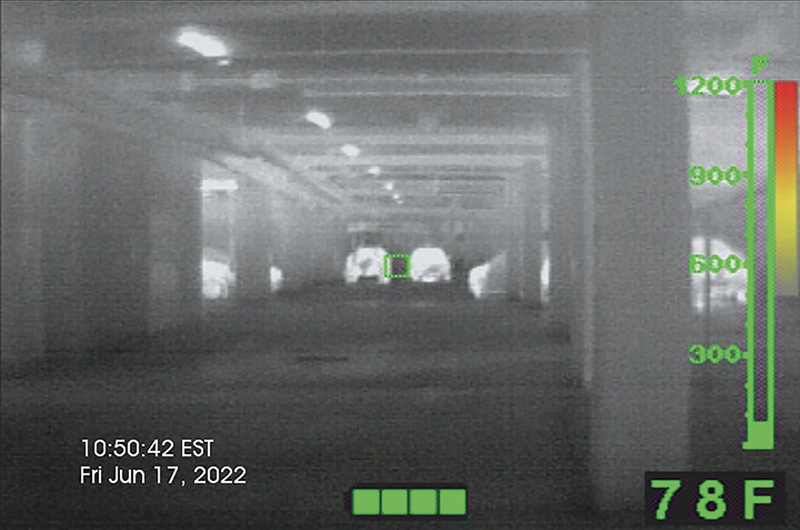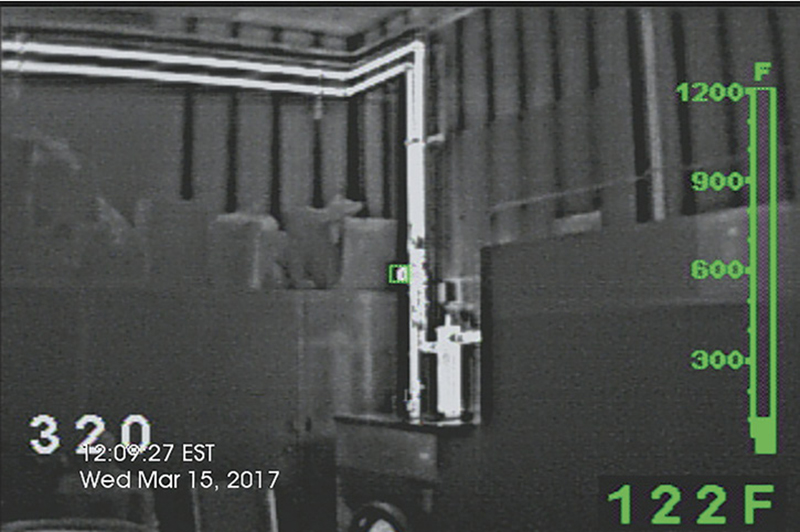
Thermal Imaging Manfred Kihn
We have seen a distinct trend toward lower-cost, smaller, lighter, and more capable thermal imagers (TI) in the fire service.

Quick advancements in technology cause the cost of that technology to fall, converting what was once unattainable into something that is now widely attainable. With higher deployment of new TI across units comes responsibility. The benefit of owning a TI relies solely on the training and interpretation of the operator.
We know that TIs are designed to process emitted infrared “heat signatures” and convert that information to an LCD screen to be interpreted by the operator. The cost, brand, resolution, or complexity of operation of a TI cannot overcome the strengths or weaknesses of the firefighter’s individual capability. A firefighter’s ability to quickly recognize a heat signature as normal/abnormal and know the TI’s reliance in all situations is the key factor to success.
Scenario 1: Atmospheric Attenuation
Recently, I talked with a captain who responded to a motor vehicle fire in a large underground parking garage. He experienced some perceived issues with the operation of the TI. They entered the structure, trying to determine the location of the vehicle, and were met with a wall of thick smoke. Using the TI was an added benefit until 13 of the structure’s sprinkler heads were automatically activated. This caused a loss of vision with the TI. The captain’s question to me was, Why did this happen? The answer is that the water particulate from the sprinkler system was dense enough to cause absorption of infrared energy from being detected or interpreted by the TI, rendering it ineffective for operation. The same effects can happen outside in heavy rain or snow or in extremely dense fog. This is called “Atmospheric Attenuation.”
Manual search procedures then went into effect, as they were unable to locate a standpipe and air management became a major concern; additional firefighting resources were brought in to control fire extinguishment. In this event, they relied heavily on their TI but quickly learned to revert to traditional search techniques.
Scenario 2: Thermal Saturation
A response to a water treatment pumphouse that showed light smoke challenged firefighters in this scenario. On investigation, the source location was condensed to a small but complex concrete mechanical room located within the structure. When firefighters made entry, they were confronted with a multitude of electrical panels, general wiring, pumps, and motors—all operating in close quarters while generating heat. This scenario created an environment bordering “Thermal Saturation.” This means that most or all the items in the field of view were close to or at the same temperature with little definition apparent on the TI screen.
- A Closer Look at Thermal Imaging for Firefighters
- Thermal Imaging Safety Training
- Thermal Imaging: Thermal Imaging Use in Fire Prevention
- Thermal Imaging: Think Strategic Deployment During Fire Attack
- Thermal Imaging: Understanding Your TI Technology
- Thermal Imaging: Look How Far We Have Come
- Thermal Imaging: Thermal Imagers Are Not Without Risks
- Thermal Imaging: How to Prevent the “White Hat Syndrome”
- Thermal Imaging: Thermal Imagers Not Just for the Crews
- Thermal Imaging: Industrial and Environmental Fire Situations Need a Thermal Imager

1 A large underground parking garage, showing normal heat signatures from vehicles and overhead lights. (Photos courtesy of Bullard.)
Investigations in such an unusual environment are hampered since a mechanical room is an atypical comparison of multiple systems generating heat. This scenario is not a typical baseline process of locating an item that is obviously warmer than its surrounding objects. With additional investigation, the firefighters were able to isolate an overheated pump motor as the source of the light smoke, although it was obscured by numerous hot water pipes and valves.
Scenario 3: Normal Use Case
In another incident, involving an electrical odor, firefighters grabbed their TI to quickly ascertain an electrical panel malfunction, as the main breaker had melted behind the panel, filling the structure with a light haze. The firefighters were quickly able to access the situation by using the TI to see the drastic temperature variation between the molten breaker and the rest of the interior wall.
APPLICATIONS
These three “contrasting” examples are at opposite ends of the interpretation spectrum. We often speak of locating the seat of a fire, conducting primary search, or finding extension of a fire in an attic or a wall. Notice that these applications usually create a sharp contrast of solid surfaces on the TI display. In many circumstances, especially in the case of investigations, the signs and clues are subtle, making image interpretation anything but automatic. Departments may go out to purchase TIs, only to check that item off their loose equipment list and move on to the next procurement need. Never overlook the most essential element of TI use: training.

2 Distinction of hot water pipes in a boiler room.
Once we move past the standard operating guidelines and explanation of technology and limitations, we fall into a black hole called applications. Every application is unique, and situations may be similar but appear vastly different on your TI display. There are a host of variables including the time of day, outside/inside temperatures, building materials, weather, access, and location. Small volunteer departments see everything larger fire departments do, just not as frequently. This puts many small and volunteer departments at a distinct on-the-job training disadvantage, as they are less likely to see the same situation twice. However, training cannot be overlooked for any variation or application.
The message is simple: Proper training with your TI develops a knowledge base of what is normal, so you can immediately recognize what is abnormal. Use your TI on calls that will help you develop greater familiarity with it. This includes car accidents and medical calls. Also, incorporate routine inspections of heaters, ballasts, freezers, stoves, furnaces, plumbing, lighting, and electrical panels. Prepare and use your TI in daytime and nighttime situations.
Environmental context and ambient temperatures can affect the speed and your ability to interpret what the TI is telling you. Understanding your TI will help you make an informed decision, enabling you to respond quickly and appropriately in the most critical situations.
Manfred Kihn is a 19-year veteran of the fire service, having served as an ambulance officer, emergency services specialist, firefighter, captain, and fire chief. He has been a member of Bullard’s Emergency Responder team since 2005 and is the company’s fire training specialist for thermal imaging technology. He is certified through the Law Enforcement Thermographers’ Association (LETA) as a thermal imaging instructor and is a recipient of the Ontario Medal for Firefighters Bravery. If you have questions about thermal imaging, you can e-mail him at manfred_kihn@bullard.com.

